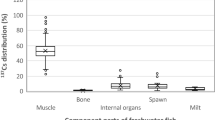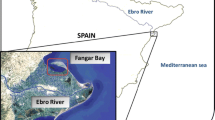Abstract
Present study was conducted to generate baseline data on radionuclide concentration in commercially important crabs around Mumbai and Sindhudurg districts of Maharashtra, India. The activity concentration of 238U, 228Ra, 40K and 210Pb were calculated in different tissues of crabs for different species, with respect to seasonal and spatial variations. The order of accumulation was gills > exoskeleton > muscle. The study shows that the observed values varied depending upon the species, locality and environmental factors.







Similar content being viewed by others
Abbreviations
- PR:
-
Premonsoon
- PO:
-
Postmonsoon
- MO:
-
Monsoon
- Mus:
-
Muscle
- Exo:
-
Exoskeleton
- CF:
-
Concentration factor
- MDL:
-
Minimum detection level
References
Anon (2015) Report on Mangrove and marine biodiversity conservation foundation of Maharashtra, an Accompaniment to Government Resolution No. S-30/2015/ CR 219/ F-3 Dated 23 September 2015, p 32
Scott JA, Palmer SJ (1990) Sites of cadmium uptake in bacteria used for biosorption. Appl Microbiol 33:221–225
UNSCEAR (1993) Dose assessment methodologies. United Nations scientific committee on the effects of atomic radiation. United Nations, New York
International Atomic Energy Agency (1989) Measurement of radionuclides in food and environment. Technical Reports Series no. 295. IAEA, Vienna, Austria
Bakshi AK, Prajith R, Chinnaesakki S, Pal R, Sathian D, Dhar A, Selvam TP, Sapra BK, Datta D (2017) Measurements of background radiation levels around Indian station Bharati, during 33rd Indian Scientific Expedition to Antarctica. J Environ Radioact 167:54–61
Bustamante P, Germain P, Leclerc G, Miramand P (2002) Concentration and distribution of 210Po in the tissues of the scallop Chlamys varia and the mussel Mytilus edulis from the coasts of Charente-Maritime (France). Mar Pollut Bull 44:997–1002
Abdullah A, Hamzah Z, Saat A, AbK W, Alias M (2015) Accumulation of radionuclides in selected marine biota from Manjung coastal area. Adv Nucl Sci Energy Natl Dev. https://doi.org/10.1063/1.4916879
Zafar M, Mn A, Mi C, Kamal M, Mzh S (2004) Radionuclides in Scylla serrata (Forskal, 1775) of Chakaria Sundarban Area. Bangladesh Asian Fish Sci 17(3–4):261–270
Raja P, Hameed SP (2010) Study on the distribution and bioaccumulation of natural radionuclides, 210Po and 210Pb in Parangipettai coast, South east coast of India. Indian J Mar Sci 39(3):449–455
IAEA (2004) Sediment distribution coefficients and concentration factors for biota in the marine environment. International Atomic Energy Agency. Technical Reports Series No. 422. Vienna
Mito K, Nishimura A, Yanagimoto T (1999) Ecology of ground fishes in the eastern Bering Sea, with emphasis on food habits. In: Dynamics of the Bering Sea. University of Alaska, Fairbanks in Sea Grant, pp 537–580
Deram A, Denayer FO, Petit D, Van Haluwyn C (2006) Seasonal variation of cadmium and zinc in Arrhena the rumelatius, a perennial grass species from highly contaminated soils. Environ Pollut 140:62–70
Lalonde BA, Ernst W, Comeau F (2011) Trace metal concentrations in sediments and fish in the vicinity of Ash Lagoon discharges from coal combustion plants in New Brunswick and Nova Scotia, Canada. Arch Environ Con Tox 61:472–481
Khan MF, Raj YL, Ross EM, Wesley SG (2007) Concentration of natural radionuclides (40K, 228Ra and 226Ra) in seafood and their dose to coastal adult inhabitants around Kudankulam, Gulf of Mannar, South India. Int J Low Radiat 4:217–231
Goddard CC, Mathews CP, AlY M (2003) Baseline radionuclide concentrations in Omani fish. Mar Pollut Bull 46:913–917
UNSCEAR (2000) Sources and effects and risks of ionizing radiation. United Nations scientific committee on the effects of atomic radiation. Report to general assembly with scientific annexes. United Nations, New York
IAEA (1985) Sediment Kds and concentration factors for radionuclides in the marine environment. Technical Report Series No. 247. International Atomic Energy Agency, Vienna
Iyengar MAR (1983) Studies on the distribution of natural radioactivity in marine organisms. Ph.D. Thesis, University of Bombay, Bombay
International Atomic Energy Agency (2014). The environmental behaviour of radium. Technical Reports Series no. 476. IAEA, Vienna, Austria
Gäfvert T, Føyn L, Brungot AL, Kolstad AK, Lind B, Christensen GC, Strålberg E, Drefvelin J, Rudjord AL (2003) Radioactivity in the marine environment 2000 and 2001. Results from the Norwegian national montoring programme (RAME). StrålevernRapport 2003:8. Østerås: Norwegian Radiation Protection Authority, http://www.nrpa.no/dokumentarkiv/StralevernRapport8_2003.pdf
Pillai KC (1985) Heavy metals in aquatic environment. In: Varshney CK (ed) Water pollution and management. Wiley, New Delhi, pp 75–93
Khan FM, Umarajeswari S, Wesley SG (2011) Biomonitoring 210Po and 210Pb in marine brachyuran crabs collected along the coast of Kudankulam, Gulf of Mannar (GOM), India. J Environ Monit 13:553–562
Khan FM, Wesley SG (2011) Tissue distribution of 210Po and 210Pb in select marine species of the coast of Kudankulam, southern coast of Gulf of Mannar, India. Environ Monit Assess 175:623–632. https://doi.org/10.1007/s10661-010-1556-7
Acknowledgements
Authors are grateful to former Director Dr. W. S. Lakra, and present Director Dr. Gopal Krishna, ICAR- CIFE, Mumbai, Project Co-ordinator Dr. A. K. Pal for providing lab facilities. We also thank funding agency Board of Research in Nuclear Sciences (BRNS), Department of Atomic Energy (DAE) and Bhabha Atomic Research Centre (BARC) by providing laboratory facilities in this work.The authors would like to thank Dr. S. K. Jha, Head, RPS (NF), HPD, BARC and Dr. M. S. Kulkarni, Head, HPD, BARC, for the constant encouragement and support.
Author information
Authors and Affiliations
Corresponding author
Additional information
Publisher's Note
Springer Nature remains neutral with regard to jurisdictional claims in published maps and institutional affiliations.
Rights and permissions
About this article
Cite this article
Khot, M., Chinnaesakki, S., Bara, S.V. et al. Baseline radionuclide concentration in commercially important brachyuran crabs around Mumbai and Sindhudurg of Maharashtra, India. J Radioanal Nucl Chem 327, 1055–1062 (2021). https://doi.org/10.1007/s10967-020-07585-9
Received:
Accepted:
Published:
Issue Date:
DOI: https://doi.org/10.1007/s10967-020-07585-9




